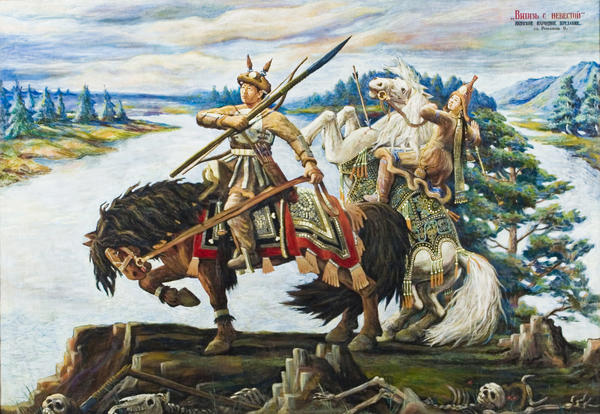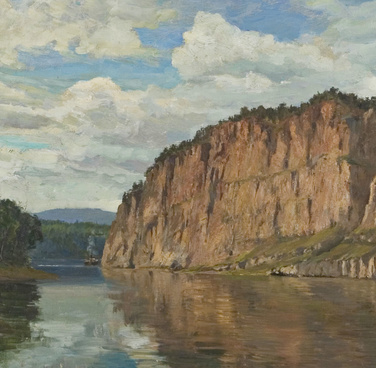The painting ‘Knight and his Bride’ was painted by Pyotr Romanov, a Yakut artist, in 1938. Romanov borrowed the scene from Olonkho, the ancient Yakut oral epic, which includes a large number of poems on a variety of subjects. They are usually performed by traditional narrators — olonkhosuts.
On the canvas, Romanov depicted the moment when an enemy arrow hits the bride’s white horse, fatally wounding it. Next to him, on another horse, the knight-groom holds a spear and a bow. He looks intently in the direction from which the arrow came, and prepares to shoot back.
The artist depicted the heroes of the epic against the background of a real Northern landscape. The knight and his bride are standing on the edge of a cliff, and behind them there is a view of the valley — a wide river with hilly banks, a coniferous forest and dense, cumulus clouds. The artist captured all the finest details that display typical Yakut scenery.
The characters' costumes are historically accurate. The bride is wearing a tangalai coat — the key element of wedding attire. Her head is adorned with a high headdress made of wolverine and lynx fur, and squirrel tail. The round silver plate in the centre of the headdress symbolizes the sun.
In Yakut culture, the bride’s clothing is commonly adorned with decorations made of silver and furs and protected with charms against the evil eye. To the Sakha people, the bride is holiest of all as someone who continues the family line.
Romanov’s creative career started in the 1930s and 1940s, when Yakutia was developing a national tradition in painting. This period was characterized by an appeal to traditional Yakut narratives and motifs. The widely popular painting “Knight and his Bride”, created at that time, has become an emblem of Yakut fine arts.
Romanov is recognized as the first professional Yakut painter. He was born in Yakutia and was an ethnic Sakha. At 22, he went to Moscow to study at the Workers' Faculty of Arts and at Higher Art and Technical Studios. He was a student of the famous masters Alexander Deineka and Dmitry Moor. After graduation, the artist returned to his homeland.
Romanov made a significant contribution to the development of art in the Republic of Sakha. He was an active public figure and the founder of the Union of Artists of Yakutia. He did large amounts of teaching and worked in a variety of genres: from designing political posters to painting theatrical scenery and carving from the tusk of a mammoth.
On the canvas, Romanov depicted the moment when an enemy arrow hits the bride’s white horse, fatally wounding it. Next to him, on another horse, the knight-groom holds a spear and a bow. He looks intently in the direction from which the arrow came, and prepares to shoot back.
The artist depicted the heroes of the epic against the background of a real Northern landscape. The knight and his bride are standing on the edge of a cliff, and behind them there is a view of the valley — a wide river with hilly banks, a coniferous forest and dense, cumulus clouds. The artist captured all the finest details that display typical Yakut scenery.
The characters' costumes are historically accurate. The bride is wearing a tangalai coat — the key element of wedding attire. Her head is adorned with a high headdress made of wolverine and lynx fur, and squirrel tail. The round silver plate in the centre of the headdress symbolizes the sun.
In Yakut culture, the bride’s clothing is commonly adorned with decorations made of silver and furs and protected with charms against the evil eye. To the Sakha people, the bride is holiest of all as someone who continues the family line.
Romanov’s creative career started in the 1930s and 1940s, when Yakutia was developing a national tradition in painting. This period was characterized by an appeal to traditional Yakut narratives and motifs. The widely popular painting “Knight and his Bride”, created at that time, has become an emblem of Yakut fine arts.
Romanov is recognized as the first professional Yakut painter. He was born in Yakutia and was an ethnic Sakha. At 22, he went to Moscow to study at the Workers' Faculty of Arts and at Higher Art and Technical Studios. He was a student of the famous masters Alexander Deineka and Dmitry Moor. After graduation, the artist returned to his homeland.
Romanov made a significant contribution to the development of art in the Republic of Sakha. He was an active public figure and the founder of the Union of Artists of Yakutia. He did large amounts of teaching and worked in a variety of genres: from designing political posters to painting theatrical scenery and carving from the tusk of a mammoth.



